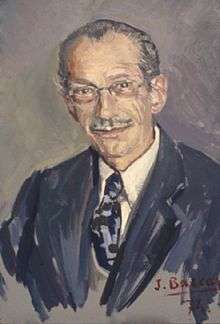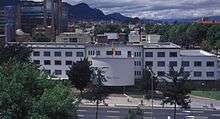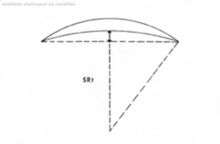Jose Barraquer
José Ignacio Barraquer Moner (24 January 1916 – 13 February 1998) was a Spanish ophthalmologist born in Barcelona[1] who did most of his life's work in Bogotá, Colombia. His original pioneering investigations on corneal transplants and correction of corneal refraction led him to be designated as “Father of modern Refractive Surgery”. His ophthalmological surgical techniques and instrumental inventions are in routine use by the ophthalmic community.[2]
José Barraquer | |
|---|---|
 | |
| Born | José Ignacio Barraquer Moner 24 January 1916 |
| Died | 13 February 1998 (aged 82) |
Biography
He was born in Barcelona, first son of Ignacio Barraquer i Barraquer (March 25, 1884 – May 13, 1965) and Josefa Moner Raguer (1893-1987).
His grandfather, José Antonio Barraquer i Roviralta (1852-1924) was a pioneer of modern ophthalmology in Spain and great histopathologist, and the brother of Lluis Barraquer i Roviralta (1855-1928), a pioneer of neurology and the founder, in 1882, of the first department of clinical neurology and electrotherapy in Spain; his son Lluis Barraquer Ferré (1887-1959) and his grandson Lluis Barraquer Bordas (1923-2010) were also famous neurologists.
Jose Ignacio Barraquer's father was a prestigious ophthalmologist due to the invention of “phacoeresis”, a surgical procedure for cataract extraction, educated him in arts and science since early childhood, giving him the possibility to become a handy-craft-man, a scientist and a skillful surgeon.
He studied medicine in the University of Barcelona and graduated 1940; in 1952 he obtained his doctorate in medicine and surgery at the University of Madrid. He trained in ophthalmology under the mentorship of his father, but also spent time visiting the most famous ophthalmic professors around Europe.

In 1938, towards the end of the Spanish civil war, he married Margarita Coll Colomé in Granada (passed 1984), where the family had been living during the war years. They had four children: Ignacio (born 1938-2012), Francisco (1940-2020)ophtalmologist, Margarita (born 1941) and Carmen (born 1946) ophtalmologist and refractive surgeon at "Clinica Barraquer". In 1940 the family moved back to Barcelona and what is now the Centro de Oftalmología Barraquer, was inaugurated in 1941; José Ignacio continued to work with his father until 1953 when he left Spain to start an independent career in Ophthalmology. He decided to settle in Bogotá, Colombia, after having traveled all around South America as an invited lecturer and surgeon.
He founded the Instituto Barraquer de América in 1964, his own Clínica Barraquer in 1968 and the Escuela Superior de Oftalmología within the Instituto Barraquer de América in 1977.
He lovely married Inés Granados in 1985, mother of his fifth child Jose Ignacio Barraquer Granados (born 1965) ophtalmologist and refractive surgeon at "Clinica Barraquer".
Nowadays Jose's legacy, Clinica Barraquer of america is a reference center for ophtalmology and refractive surgery in the world, his dream as an ophtalmologist and refractive surgeon is continued by his descendants Carmen Barraquer and Jose Ignacio Barraquer Granados among other great ophthalmologists that are in the clinic which had the opportunity to learn from the “Father of modern Refractive Surgery”.
Research and development
In his first ophthalmological article, published in 1942, he presented his first ophthalmological instrument, the Barraquer Keratotome with pneumatic fixation which he created to perform more precise cataract incisions. From then until 1950, he published 56 articles among which the most notable are Air injection in the anterior chamber in cataract surgery (1946), Histiotherapy (1948),Curare in Ocular surgery (1949), Current selection technique in Keratoplasty (1949) in which he described the “edge to edge” suturing technique in penetrating grafts, routinely usedpo +n< i9 in corneal grafts since then; and Refractive Keratoplasty (1949), his first article on the optical theory to correct myopia and hyperopia by modifying de anterior corneal radius of curvature, published in Spanish, English, French and German.

In Colombia, he continued his research and developments in corneal transplants, refractive keratoplasty and lens surgery. In 1956 he published The microscope in ocular surgery and The continuous edge to edge suture in full thickness grafts ; he designed and built several bnew surgical instruments like the “hemostatic forceps”, “cataract scissors”, “trephines for corneal grafts” and the “colibri blefarostat for anterior segment surgery”. This last instrument was an idea of his first pupil in Bogotá, Enrique Ariza Henao, and was described in the journal “Archivos de la Sociedad Americana de Oftalmología y Optometría” that he started in 1958.
Meanwhile, he continued to advance his research in refractive keratoplasty in his private home laboratory; in 1958 he published Method for cutting lamellar grafts in frozen corneas, new orientation for refractive surgery and Cinematography of ocular operations . In the meantime between 1962 and 1964 he designed and hand made several precision surgical instruments including the “Microkeratome”, the“Neumatic fixation rings”, “the applanation tonometers” “the applanation lenses” to measure the diameter of the resection made with the microkeratome, and perfectioned “the Lathe to cut spherical surfaces”. In 1963 he published Two level keratoplasty , Modification of corneal refraction by means of intracorneal inclusions . In 1964 Corneal behavior in response to thickness changes in which he first describes the changes on the anterior radius of corneal curvature, in response to lamellar grafts of different thickness performed in rabbits; Keratomileusis for correcting myopia where he describes the microkeratome, instrument designed and built by him in 1962, to perform corneal lamellar resections of different diameters and thickness; and New approach, for the surgical correction of myopia . In 1965 he published 19 articles including “Our approach in Pterigium surgery” explaining the free conjunctival graft technique; The corneo-conjuntival limbal reconstruction before a corneal transplant in which for the first time a graft of limbus tissue was recommended, and Foundations of Refractive Keratoplasty with a foreword dedicated to his father, where he explains all his research, findings, the microkeratome and the surgical technique of Keratomileusis and Keratophakia. In this article he explains "The Law of Thickness'" discovered through his research work, and that is nowadays the foundation of LASIK (Laser assisted Keratomileusis) and of every corneal refractive technique that is being performed worldwide.

In 1967 he published A new operating microscope for ocular surgery describing a microscope developed jointly with his brother Joaquin Barraquer Moner and the physicist Hans Littmann from Zeiss. In 1970 he edited and published a book (2 volumes)20 compiling the available reprints on Refractive Keratoplasty which had appeared in the world literature since 1949.
In 1980 he wrote and published his first book called Keratomileuisis and Keratophakia (1 volume) in which he describes all his life research to modify the corneal refraction, his findings, different approaches, mathematical and geometrical foundations, the surgical instruments that he created, results of the surgical techniques of Keratomileusis and Keratophakia in patients, and the complications encountered.
In 1989 he published a second book Refractive Surgery of the Cornea (2 volumes) with the collaboration of Carmen Barraquer-Coll his daughter, and Alejandro Arciniegas-Castilla, revising his first book as well as describing the lamellar and incisional surgical techniques developed by other ophthalmologists to modify corneal refractive power: Radial and astigmatic keratotomies, epikeratophakia and the first steps on laser refractive procedures.
Between 1977 and 1985 he organized and directed refractive surgery training courses at the Barraquer Institute of América in Bogotá, that were attended by over 100 ophthalmologists from all the world. He also organized 5 International Forums in Bogotá, (1970, 1975,1980,1984,1993) that were attended by the most important worldwide ophthalmological professors
During his professional life he wrote 268 articles, invented 19 surgical techniques and created 45 surgical instruments
Awards
- 1968 - Grand Honor Award for outstanding Achievements. Society of Cryo-Ophthalmology
- 1972 – Distinguished Service Prize Award for Excellency in Ophthalmology-Society of Contemporary Ophthalmology (U.S.A)
- 1976 – Gold Medal to the Microsurgeon of the Year. - World Microsurgery congress (U.S.A)
- 1982 – Karl Wessely Gold Medal- Augenerztliche Fortbildung (Germany)
- 1983 – José Ignacio Barraquer Moner Medal and Lecture – The International Society of Refractive Surgery (U.S.A)
- 1985 – Escudo Virgili- Facultad de Medicina de la Universidad de Cadiz (Spain)
- 1987 – First Albrecht von Graefe Award for distinguished contributions to Refractive Surgery. – The American Society of Contemporary Ophthalmology (U.S.A)
- 1987 – Medaglia D’Oro “ G.Cirincione” – Universita de la Sapienza di Roma (Italy)
- 1987 – Gold Medal Leonardo da Vinci – National Eye Research Foundation (Chicago – U.S.A)
- 1994 – Award “The ophthalmologist of the Century”. The International surgery Club (Montreal-Canada)
- 1998 – The Most Influential Ophthalmologists of the Twentieth Century.- The American Society of Cataract and Refractive Surgery (Seattle- U.S.A)
Decorations
- 1968 – Commander of the Order of San Carlos (Colombia)
- 1968 – Commander with Plaque of the Civil Order of Alfonso X, the Wise (Spain)
- 1976 – Silver Medal of Merit in Labour – Ministry of Labour (Spain)
- 1977 – Caballero de Honor y Mérito de la Orden de Malta (priorato de U.S.A)
- 1980 - Commander of the Order of Boyaca (Colombia)
- 1983 – Gran Cruz de San Jorge y Constantino el Grande - Orden Constantiniana de San Jorge (Colombia)
- 1984 – Grand Officer of the Order of Boyaca (Colombia)
- 1995 - Grand Cross of the Civil Order of Alfonso X, the Wise (Spain)
Academic distinctions
- 1961-1973 - Visiting professor of Ophthalmology – Baylor University, College of Medicine, (Houston, U.S.A)
- 1967 – Académico de Honor de la Real Academia de Medicina de Murcia (Spain)
- 1969 – Awarded title of doctor honoris causa by the Federal University of Santa Maria (Brasil)
- 1970 – Miembro de Mérito de la Academia de Ciencias Médicas de Barcelona (Spain)
- 1975 - Honorary Professor in the National University of San Marcos (Perú)
- 1987 – Awarded title of doctor honoris causa by the University of Cádiz (Spain)
- 1990 – Awarded title of doctor honoris causa in ophthalmology by the University of Cartagena(Colombia)
27 Awards, 23 decorations, and 27 Distinctions
Publications
1- Nueva talla del colgajo para la extracción total de la catarata. Archivo Sociedad Oftalmológica Hispanoamericana. 1942 Vol 1 p 464 Estudios e informaciones oftalmológicas. Cuaderno II, América Clínica Vol 7, N9-10, p102. 1945 Clínica y Laboratorio p 388, 1947
2- La inyección Intraocular de Aire en la operación de la catarata. Arch Soc.Oftal.Hisp.Amer 1946 Vol 6 N4 p339 and in Arch.Chilenos de Oftal de Julio-Octubre p 261
3- Histioterapia .- Estudios e Informaciones Oftalmológicas 1948 Vol 1 N9 Medicamenta p 221 Archivos Medico Quirúrgicos y del Trabajo año 3, N 11 y 12
4- El Curare en cirugía ocular. Estudios e informaciones oftalmológicas 1949 Vol 2 N 8 La Presse Médicale 4-8-51 Medicina Oct 1951 p 83
5- Actual técnica de elección en Queratoplastia. Arch.Soc.Oftal Hisp Amer, 1949 Vol 9 p 152
6- Queratoplastia Refractiva; Estudios e informaciones oftalmológicas 1949 Vol 2 N 10
7- The microscope in ocular surgery 1956 -Am. J. Ophthalmol., Vol 42 p 916
8- The continuous edge to edge suture in full thickness grafts; 1956: Archives of Ophthalmology Vol 56 p 426
9- Method for cutting lamellar grafts in frozen corneas. New orientation for refractive surgery; 1958 Arch.Soc.Amer.Oftal.Optom Vol 1 p 237
10- Cinematography of ocular operations; in collaboration with Ignacio Barraquer Coll 1958 Arch.Soc.Amer.Oftal.Optom Vol 1 p 307
11- Two level keratoplasty; International Ophthalmology Clinics 1963 Sept Volume 3 Issue 3
12- Modificación de la refracción por medio de inclusiones intracorneales. 1963; Arch.Soc.Amer. Oftal.Optom Vol 4 p 229
13- Conducta de la córnea frente a los cambios de espesor (contribución a la cirugía refractiva); 1964, Arch.Soc.Amer.Oftal.Optom Vol 5 p 81
14- Queratomileusis para la corrección de la miopía. 1964, Arch.Soc.Amer.Oftal.Optom Vol 5 p27-47 and in An.Inst Barr Vol 5 p 206
15- New approach for the surgical correction of myopia 1964 Presented at the 1st International conference on Myopia. New York. Prof.Press.Inc.Chicago
16- Our approach in Pterigium surgery. 1965, Proceedings of the World Congress of Cornea. Butterworth Inc, Washington p 351
17- The corneo-conjuntival limbal reconstruction before a corneal graft. 1965; Proceedings of the World Congress of Cornea. Butterworth Inc, Washington p 354
18- Bases de la Queratoplastia Refractiva. 1965; Arch.Soc.Amer. Oftal.Optom Vol 5 p 179
19- A new operating microscope for ocular surgery. 1967; Amer J, Ophthal 63, 90 Nª1
20- Queratoplastia Refractiva (2 volumes); 1970, edited by Instituto Barraquer de América.. Bogotá, Colombia
21- Queratomileusis y Queratofaquia; 1980, edited by the Instituto Barraquer de América. Litografía Arco.Bogotá,Colombia
22- Cirugía Refractiva de la Córnea,(2 volumes) LXV Ponencia de la Sociedad Española de Oftalmología 1989. Edited by the Instituto Barraquer. OP Gráficas, Bogotá, Colombia.de América.
References
- "Josep Ignasi Barraquer i Moner". L'Enciclopèdia.cat. Grup Enciclopèdia Catalana. Retrieved August 27, 2016.
- Domínguez, Alfredo (1998). "José Ignacio Barraquer Moner". Archivos de la Sociedad Española de Oftalmología (in Spanish). 73 (4): 185–186.